by
Dipl. Biol. M. Kaulin
Institut für Fangtechnik, Bundesforschungsanstalt für Fischerei
Hamburg, Federal Republic of Germany
In the introductory report about eelfishing methods it was mentioned that eel fishermen generally are specialists. Among these specialists is the group of fishermen who operate with longlines only. This method needs a lot of experience. The successful fisherman has to know how to construct the longline; where in the lake or river, backwater or sidewater, it has to be set and at what time and how; finally which kind of bait is the best one to use. This knowledge can only be acquired by many years of practical work.
In this report about longlining for eels a summary of this important fishing method will be given.
During the feeding season good catches of eel can be made with longlines. For this fishing method a relatively small expenditure of material and manpower is necessary.
Generally speaking the basic construction of a longline for eels does not differ from any other one. Each longline consists of a mainline to which the branchlines with hooks are attached at equal distances.
There are many variations in the construction of the eel-longline as regards the twine numbers for main and branchlines; the length of branchlines; the distances between the branchlines and, last but not least, the shape and size of the hooks. Therefore in describing the gear some examples only are given.
Today all eel-longlines used in German freshwater fisheries are made of twisted or braided synthetic yarns, mainly polyamide-continuous, sometimes staple fibre. The specification of yarns used for mainlines varies from 23tex × 21 to 23tex × 36; the yarn numbers for branchlines vary between 9 and 23tex × 18. Sometimes for the branchlines polyamide-monofilament is also used, with a diameter of 0.40 mm to 0.60 mm. To these branchlines the hooks are attached with special knots (Fig.1). Generally the material of the branchlines is weaker than that of the mainlines.
In our eelfishery longlines the distances between the branchlines range from 1.8 to 4.5 m and the lengths of the branchlines themselves vary from 0.3 to 1.8 (Fig. 1). Branchlines should never be longer than half the spacing between them, in this way the entangling of the hooks with each other will be avoided.
Normally an eel-longline is made up of sections, each consisting of from 100 to 250 hooks. Ten or four sections respectively with one thousand hooks in all are set out. But there are also fishermen who operate with up to three thousand hooks.
The choice of the right shape and size of hooks is also of great importance in eelfishing. A small hook can be swallowed too deeply by the eel, which is undesirable. On the other hand a large hook cannot be taken by a small eel. In handling the longline and when baiting the hooks, they must also be of a suitable size and be of a good shape. Two types of hooks (Fig. 2) of the following numbers are used by the German fishermen:
The “Kirby hook”, with a point bent sideways, of sizes No. 2/0 to No. 2 and
The “Carlisle hook”, with a straight point, of sizes No. 18/10 mm and No. 18/7 mm.
Of these two types the first one is mostly preferred. In the opinion of fishermen the hook with the point bent sideways allows of quick baiting with small fish: the other hook, the so-called “Carlisle hook”, made of finer wire, is preferable for baiting with dew worms.
Before speaking about baits some remarks are appropriate about the characteristics of hook-sizes. The size numbers for hooks do not give a clear indication of the true size of the hooks. These numbers have been more or less introduced arbitrarily. The size of a hook may be better indicated by its hook spread (Fig. 3). This means the widest distance between the outside edge of the hookshank and the outside edge of the bend. It is not the distance between the point and the inner edge of the shank. This is called the hook opening or the gap of the hook.
In the case of the “Carlisle hooks” the hook spread has already been added to the size number by the manufacturer. The hook spread for the “Kirby hooks” has been measured in addition. It ranges from 12.3 mm for No. 2/10 to 9.5 mm for No. 2.
The provision of bait causes many problems. This refers not only to the question of which kind of bait is the most attractive for catching eel with longlines, but also sometimes to the difficulty of procuring the bait in sufficient quantity. The fishermen use dew worms which are collected during the night after the rain by the light of a hand-lamp. But with this kind of bait small eels mostly are caught. Crayfish, after the moult, or crayfish tails are also considered to be effective baits, but they are seldom available in a sufficient quantity. Crushed freshwater snails are sometimes used. But the most important baits in eelfishing are small living, sometimes also dead, fish of the following species:
smelt (Osmerus eperlanus L.),
bleak (Alburnus lucidus Heck),
gudgeon (Gobio fluviatilis Cuv.),
small roach (Leuciscus rutilus L.),
small perch (Perca flubiatilis L.), and
stone perch (Acerina cernua L.).
According to some fishermen the following fish are sometimes useful:
red eye (Soardinius erythrophthalmus L.)
white bream (Blicca björkna L.) and
stickleback (Gasterosteus aculeatus L.).
Fishing for live bait is carried out by means of special bait seines; with lift nets; with skimming nets; with double stick bait nets (Fig. 4) or sometimes with small trawls with very small mesh in the codend.
The small fish caught with one of these methods are held in small meshed net bags or bait cans until they are needed for baiting the longline.
In order to keep the longline from becoming entangled it is necessary to store the hooks separately. The fishermen do this in different ways. Very popular is the use of clamps in which the hooks are inserted one after another (Fig.5). In each clamp the hooks of one longline section are stored. The mainline is put loosely in a wooden tray. Another method of storing the hocks is shown in Figure 6. Here the hooks are stuck into strips of cork nailed upon cross battens of a ladder-shaped framework. The strips of cork can also be attached to the edge of a basket or box (Fig. 7). Lastly a method of storing the hooks is mentioned where neither clamps nor cork-strips are used. The hooks are hung upon a piece of strong wire on one of the narrow sides of the box (Fig.8). During transportation the hooks are prevented from falling down by being bound with a piece of yarn.
After the longline and the hooks have been stored in one of these ways, they are ready for baiting and setting. If the fisherman is using living small fish for bait, then the hooks are baited during setting. These fish are fixed to the hook by sticking the point through the dorsal muscle, sometimes also through the lips without unduly wounding the fish. In this way the fish can be kept alive for a longer time. Dead fish are also useful for baiting but only as long as the water is not too warm. These baits are attached to the hook by sticking the point through the head or through the operculi.
Normally two men are necessary on board a motor or rowing boat for setting the longline. One man baits the hooks and throws out the line while the other one keeps the boat on the right course and at the right speed. The man setting the line has to ensure that the mainline is not stretched out too tight on the ground. Setting the line loosely on the ground (Fig.9) is preferable because otherwise the eel taking the baited hook would soon feel the resistance of the line and would let the bait go. The beginning and the end of the longline are marked by anchored buoys. But because of fish thieves in some lakes the fishermen sink the ends with sinkers down to the bottom without any bouy. For hauling the line, one end is caught and taken up by a little searching anchor.
In this connection it must be mentioned that the eel-longline is not always a groundline. In some cases, if the fishing conditions make it necessary, the mainline is lifted up more or less from the ground by attaching little floats and sinkers alternately (Fig. 10).
Another method of setting the line is used if the hooks are baited with dew worms. In this case the hooks are already baited on shore. The baited hooks are put one after another in rows into wet sand in a special box and covered with sand. The mainline is then put loosely on top of the sand. One side of this box must be left open, in order that during setting the line with the hooks can run off freely by itself after the start of it has been sunk in the water.
The time for setting the line is the late afternoon or the evening. Fishermen advise that it is advantageous to start hauling the line early in the morning because later the caught eel becomes too active, and some of them escape.
Two men are necessary also for hauling the eel-longline. One of them hauls the line and places it in the wooden box from which the line has been set out. The second man follows the line with the boat.
The eels caught are out from the branchline and put into a waterfilled tank or net bag in the beat in order to keep them alive.
After cleaning the longline and replacing the missing hooks on shore, the gear is made ready for setting again, the hooks being stored on clamps, cork-strip etc. as described before and the line coiled down in the box.
| McGrath | - | asked for information on removal of hooks. |
| Kaulin | - | the eels are cut open when the hooks are swallowed deeply, otherwise the hooks are pulled out. |
| McGrath | - | suggested that pulled-out hooks could result in death in transit. |
| Kaulin | - | not aware of damage. |
| McGrath | - | was sinker and float arrangement required to counteract effects of thermal stratification? |

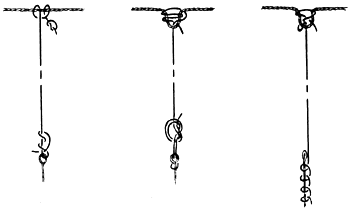
Fig. 1 Construction details of an eel-longline with descriptions of different knots for attaching branchlines to the mainline and hooks to the branchlines
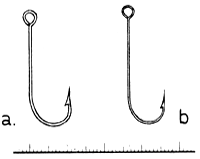 | 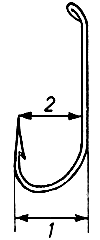 | 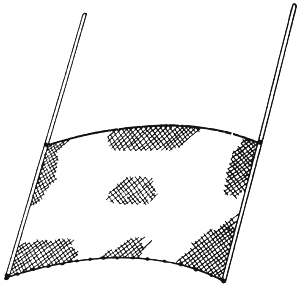 | |||
| Fig. 2 | “Kirby hook” (a) and “Carlisle hook” (b) | Fig. 3 | Hook spread (1) and hook opening (2) | Fig. 4 | Double stick bait net |
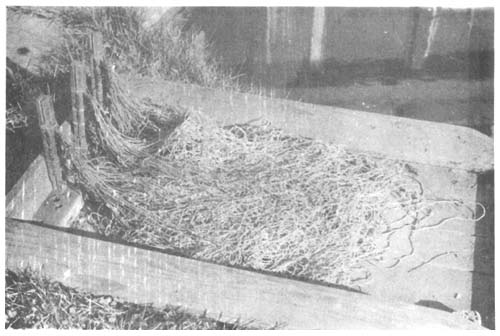
Fig. 5 Storing the longline for eel. The mainline has been coiled in a wooden box, the hooks are put into clamps.
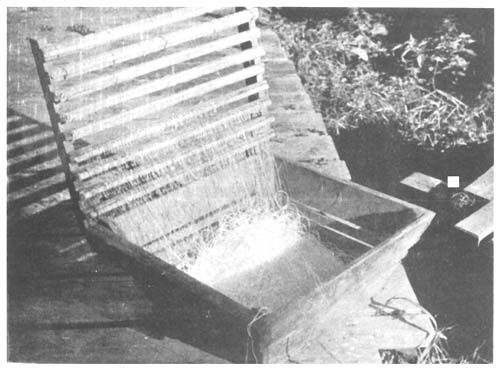
Fig. 6 The hooks have been stuck into stripes of cork upon battens of a ladder shaped frame-work.
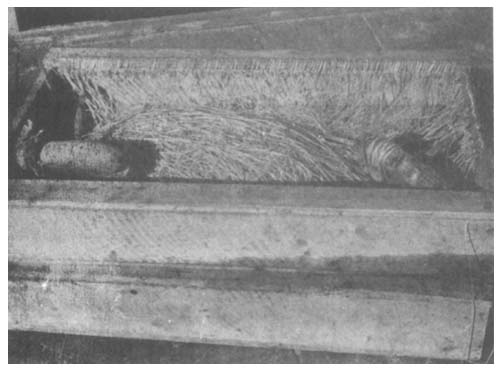
Fig. 7 Sticking the hooks into the border of the wooden box. To the border also stripes of cork can be attached.

Fig. 8 For storing the hooks they have been hanged over a piece of stronger wire.

Fig. 9 Setting the longline loosely to the ground.

Fig. 10 Lifting up the eel-longline from the ground by attaching floats and sinkers alternately to the mainline.